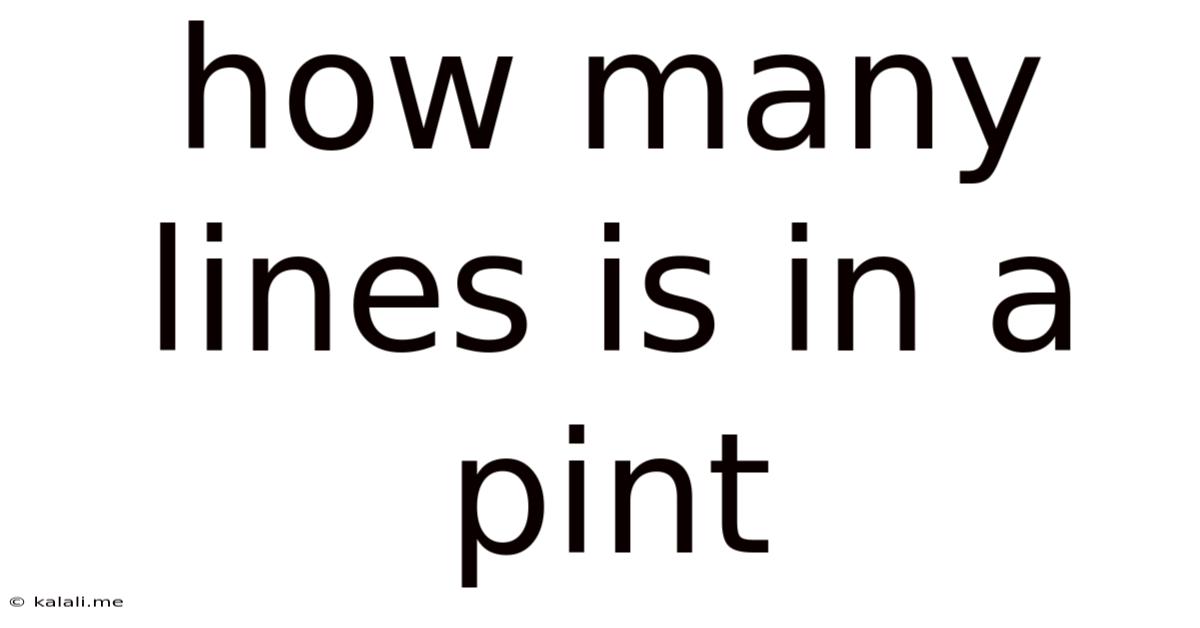How Many Lines Is In A Pint
Kalali
Aug 26, 2025 · 4 min read

Table of Contents
How Many Lines Are in a Pint? Deconstructing the Unanswerable Question
The question, "How many lines are in a pint?" is inherently ambiguous and doesn't have a single, definitive answer. It's a fascinating example of how seemingly simple questions can reveal the complexities of measurement, units, and even the nature of lines themselves. This article will delve into the various interpretations of this question, exploring the geometrical, liquid measurement, and even poetic possibilities, ultimately demonstrating why a straightforward numerical answer is impossible.
Understanding the Ambiguity: Lines as a Concept
The crux of the problem lies in the undefined nature of "lines." We must first consider what we mean by "lines" in this context. Are we talking about:
-
Lines of liquid: Perhaps the question refers to the number of imaginary horizontal lines one could draw across a pint glass, dividing it into infinitesimally thin layers of liquid. In this case, the answer is theoretically infinite. There's no limit to how many infinitely thin slices you can imagine.
-
Lines of sight: If we consider lines of sight, how many distinct visual lines could one draw while observing a pint of liquid? This depends on the observer's perspective, the resolution of their vision, and the level of detail they wish to perceive. Again, the answer is subjective and potentially vast.
-
Lines of text: Could the question refer to the number of lines of text one could write about a pint? This would depend entirely on the length and style of writing. A short, concise description might take only a few lines, while a detailed scientific analysis could span many pages.
-
Lines of code: If the question relates to programming, "lines" might refer to the number of lines of code needed to simulate a pint of liquid in a computer program. This would depend heavily on the complexity of the simulation and the programming language used.
-
Lines of latitude and longitude: In a more abstract sense, one could consider the geographical lines of latitude and longitude that intersect the location where the pint is situated. But this is wildly tangential to the initial question.
The Physics of a Pint: Liquid Volume and Measurement
A pint is a unit of liquid volume, typically defined in imperial or US customary units. Understanding the physical properties of the liquid within the pint is crucial when discussing the question of "lines." The liquid itself is not inherently structured with "lines." The concept of "lines" is an imposed construct for the purposes of measurement or visualization.
- Imperial Pint: A UK pint is approximately 568 milliliters.
- US Pint: A US liquid pint is approximately 473 milliliters.
These precise measurements, however, don't provide any information about the number of "lines" in a pint. They define the volume, not the visual or conceptual lines that one might superimpose.
Mathematical Considerations: Infinite Divisibility
From a purely mathematical perspective, the number of lines within a pint (assuming we interpret "lines" as infinitely thin horizontal slices) is infinite. This stems from the principle of infinite divisibility—the idea that any continuous quantity, like the volume of a liquid, can be theoretically divided into an infinite number of smaller parts.
Practical Applications and Interpretations:
Let's explore some practical scenarios where the idea of "lines" within a pint might appear:
-
Beer Tasting Notes: A beer sommelier might meticulously describe the visual aspects of a pint of beer, including the clarity, color gradients, and perhaps even subtle layering effects. Here, "lines" could represent transitions between different shades or concentrations within the liquid, but this is still a subjective observation and not a precisely quantifiable number.
-
Layer Separation in Liquids: In some mixtures, different components might separate into distinct layers. One could then count the visible boundary lines between these layers. However, the number of these lines depends entirely on the specific liquid and the mixing process.
-
Calibration Marks on a Measuring Jug: A pint measuring jug often has markings to indicate specific volumes. These marks could be considered lines, but they are a finite and limited number, typically representing fractions of a pint (e.g., half-pint, quarter-pint).
Conclusion: The Elusive Answer
The question "How many lines are in a pint?" highlights the importance of precise definition in scientific and mathematical contexts. The lack of a clear definition of "lines" makes the question unanswerable in a straightforward numerical sense. The answer depends entirely on the interpretation of the word "lines" and the context in which the question is posed. While we can explore various interpretations involving infinite divisibility, subjective observation, and practical applications, there's no single, universally correct answer. The very ambiguity of the question serves as a valuable reminder of the importance of clear communication and the subtle nuances of language. It's a fascinating thought experiment that demonstrates the limitations of applying simple mathematical concepts to complex, real-world scenarios. The true answer lies not in a number, but in understanding the multifaceted nature of the question itself. This exploration into the seemingly simple query opens up avenues for discussions in mathematics, physics, and even the philosophy of measurement. The "lines" in a pint are as numerous and varied as the interpretations themselves.
Latest Posts
Latest Posts
-
How Many Cups In Box Confectioners Sugar
Aug 26, 2025
-
Why Did The Cow Do Jumping Jacks
Aug 26, 2025
-
How Many Calories In A Pound Of Rice
Aug 26, 2025
-
How Many Degrees Are In An Isosceles Triangle
Aug 26, 2025
-
If You Was Born In 1986 How Old Are You
Aug 26, 2025
Related Post
Thank you for visiting our website which covers about How Many Lines Is In A Pint . We hope the information provided has been useful to you. Feel free to contact us if you have any questions or need further assistance. See you next time and don't miss to bookmark.